Dec 31, 2025
Dec 31, 2025
Director: Hiroshi Teshigahara /Japan/Japanese/123 mts
Woman in the Dunes is a superb film adaptation of a fascinating novel by Kobo Abe. The film won the Special Jury Prize at the 1964 Cannes Film Festival [and, somewhat unusually for an avant-garde film, was nominated for the Best Foreign Language Film Oscar in the same year (losing out to Italian film Yesterday, Today and Tomorrow).
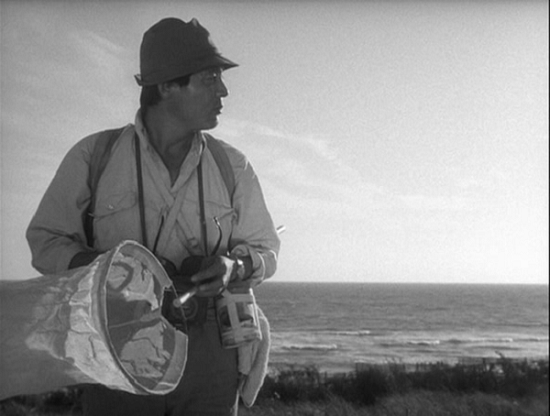
Jumpei Niki the entomologist arrives in dunes
Abe was heavily influenced by Kafka and wrote several very strange and unforgettable books, but this was his masterpiece. He scripted the movie himself, and the director Hiroshi Teshigahara obviously "got" the material, so the film is also a masterpiece. It includes some of the most striking visual imagery ever seen in cinema.
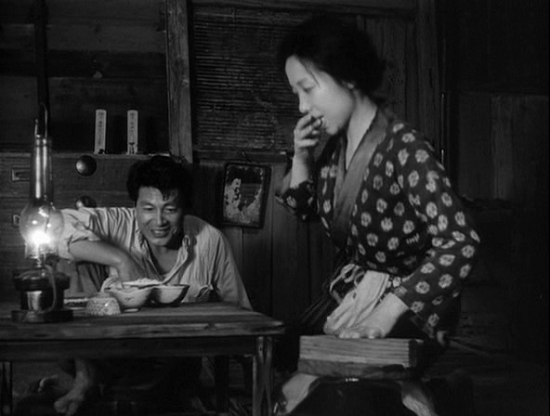
Jumpei Niki lands in the pit hut and eats his meal
Jumpei Niki, a Tokyo based entomologist and educator, is in a poor seaside village beach collecting specimens of sand insects. His desire is to get his name into the entomology books, because his actual job is never going to win him any appreciation. He muses in an opening voice-over about what it takes to be a member of society, and whether it is worth it.
At one point, the entomologist collects an antlion. This insect is from the family Myrmeleontidae. The larval stage is often called a "doodlebug" in the United States. The insect ensnares its prey by digging out a pit in loose sand. When the prey falls into the pit, it is unable to get out and becomes food for the ant lion. This is symbolic of the situation the entomologist himself encounters when he is trapped in the sand pit.
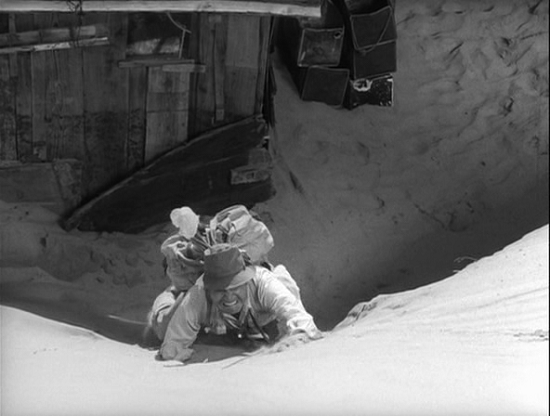
A vain attempt to escape from the pit
During his job, he falls asleep on the beach and wakes up to find that the last bus to civilization has already left. Some townspeople offer to ask an ‘old woman’ if he can stay with her for the night, and he agrees. He discovers that the ‘old woman’ is a young and beautiful widow (Kyoko Kishida) who lives in a crude hut at the bottom of a sand pit in the dunes. He has to climb a ladder down to her, and sand is everywhere. He is rude to her initially. He is also amused and attempts to correct her when she claims that the sand gets into everything and makes it rot. He wonders why she starts digging buckets full of sand late at night. He goes to sleep, wakes the following morning to find her naked and beautiful, but attempts to leave instead.
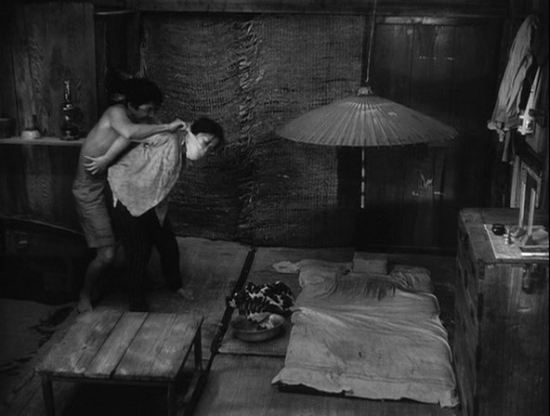
Jumpei Niki in anger ties up the woman
He soon realizes that he has been tricked: the ladder is gone, there is no way up the crumbling walls all around him, and if he does not help every night in shoveling away the sand that endlessly pours into the pit, the house, and possibly the entire village, will be buried. In time a bond develops between the lonely woman and her reluctant 'guest', a fragile accommodation is reached, and even the entomologist's determination to escape is gradually eroded as he finds for himself a new and unexpected sense of purpose in his harsh surroundings.
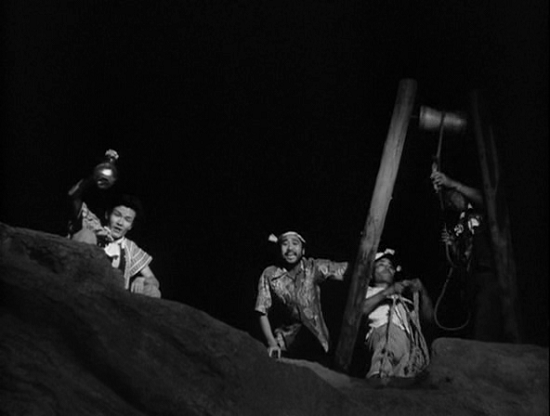
The villagers from the top of the pit after dumping him back
Hiroshi Teshigara's film opens with the image of a strange crystal shape whose uneven enormity fills the entire screen, challenging viewers to identify what it is. The next, equally baffling shot, taken from further back, is of a pyramid-like pile of these alien rocks, still difficult to recognize in all their misshapenness. Finally, the camera pulls out to a distance, revealing that the boulders are in fact countless tiny grains of sand forming a desert dune.
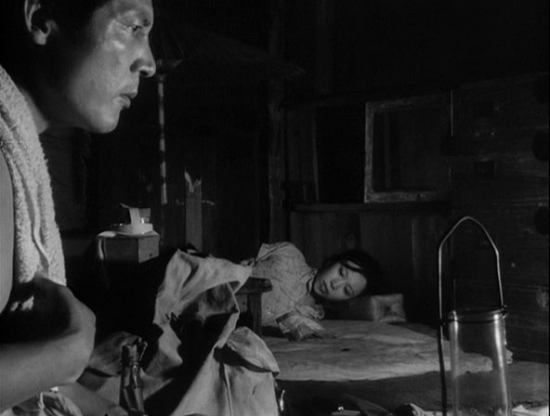
Jumpei Niki listens to the woman's hard life in pit
It is a beautiful, mysterious sequence that foreshadows the two elements that will come to dominate the film: the microscopic scrutiny to which an apparently simple scenario and blank characters will be subjected, exposing all manner of hidden complexities and the inescapable ubiquity of sand, covering the sets, caking bared flesh, and filling the soundtrack with its constant presence.
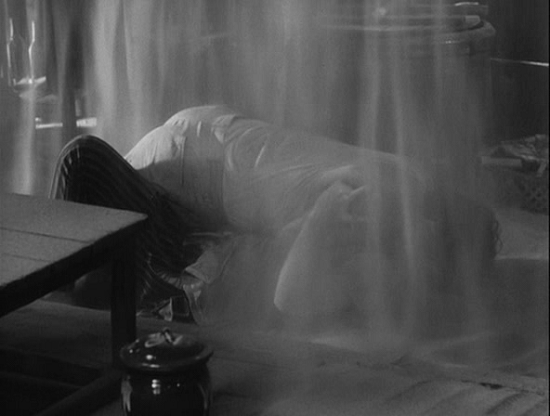
Safeguarding each other when a rain of sand seeps into the hut
Does the entomologist embody post-war Japan, trying to claw its way out of a dead-end past to a more rationalized future? Is he a 20th century Everyman, alienated, rootless, restless, emasculated and incapable of love? Or is he a Sisyphus figure, doomed forever to a hell of futilely repetitive labor? Or perhaps a Kafkaesque anti-hero, pinned down like one of the bugs that he collects yet longing to take wing and rise above his mundane existence? Is his relationship with the widow outlandish from start to finish, or is it really just like any marriage of convenience, complete with opportunistic sex and the sort of guarded affection that comes only from habit? Is the entomologist ultimately a deluded prisoner, or has he achieved true freedom in the most unlikely of circumstances? And might not the film's decidedly surreal events all just be dreamt up by the entomologist as he dozes under the sun and tries to imagine escaping a troubled marriage and an over-regimented life in the city?
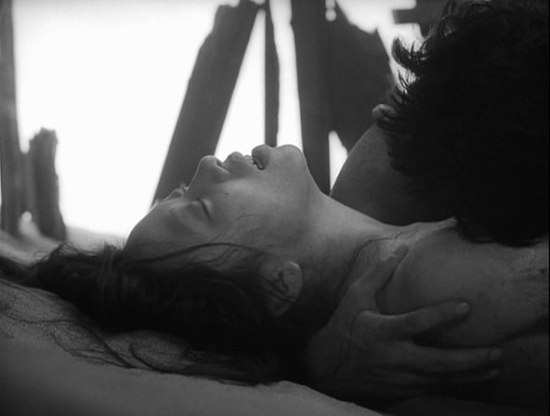
Sharing a moment of intimacy with the woman of the dunes
Yet, so disarmingly simple is the premise of Woman in the Dunes, so sparse are its landscapes, and so economic its characterization, that the film's desert becomes a mythic space onto which all manner of allegorical interpretations can be projected. The film is probably one of the most beautiful black and white films ever made. The lush images of the rolling dunes start out lazy and peaceful, gradually become threatening and claustrophobic, and then become almost comforting, making us see things in the same way as the protagonist. The film is shot almost entirely in a near-darkness; shapes are blurred, bodies blend in with the walls and the sand. The shots of their physical relationship, from fighting to lovemaking (little of which is actually shown, and all of which is very suggestive) are among the most sensuous images ever captured on film.
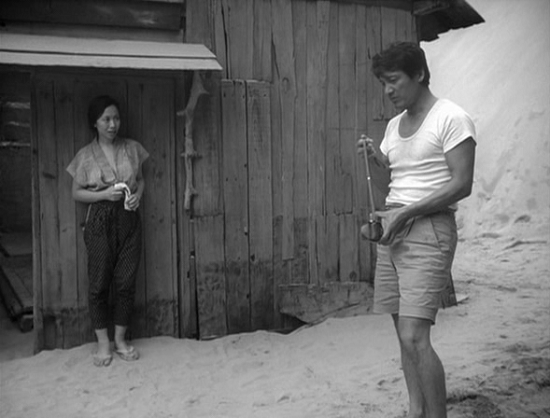
Surveying the terrain outside the hut
Cinematographer Hiroshi Segawa's use of feverish camera angles and unusual close-ups ensures that the cabin setting, though confined, is always a place of nervous thrills, while Takemitsu's discordant soundtrack combines shrill string glissandi with pounding tribal drums, insect scuttles and howling wind, leaving viewers no chance to relax or drift. Okada and Kishida give performances of intense (but incompatible) longing, and do not shy from their characters' less agreeable sides. Best of all, though, is the sand itself, rippling, spilling and entrapping in a compelling vision of nature at its most oppressive and unrelenting.
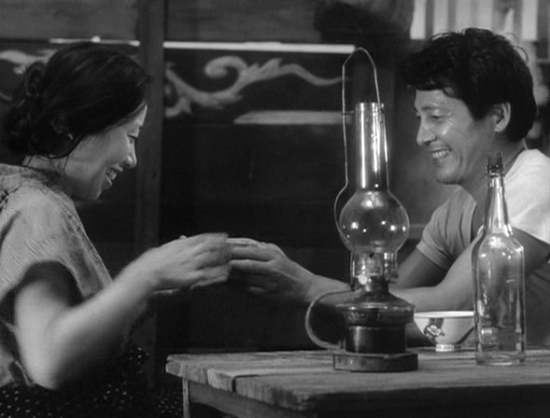
Sharing another good moment before his final attempt to escape
In the end such questions remain mere riddles in the sand, but there can be no doubt that Woman in the Dunes, the second (after 1961's Pitfall) of Teshigahara's collaborations with the avant-garde novelist Kobo Abe and the experimental composer Toru Takemitsu, is a richly evocative masterpiece of domestic claustrophobia, erotic tension and existential crisis.
Woman in the Dunes is a raw portrait of existence in extremis. As beguiling, enigmatic and timeless as the shifting sands, Teshigahara's finest film pulls the viewer in and refuses to let go.
A series of "Hundred Favorite Films Forever"
15-Dec-2012
More by : P. G. R. Nair

|
Beautiful review. I must see this film! |